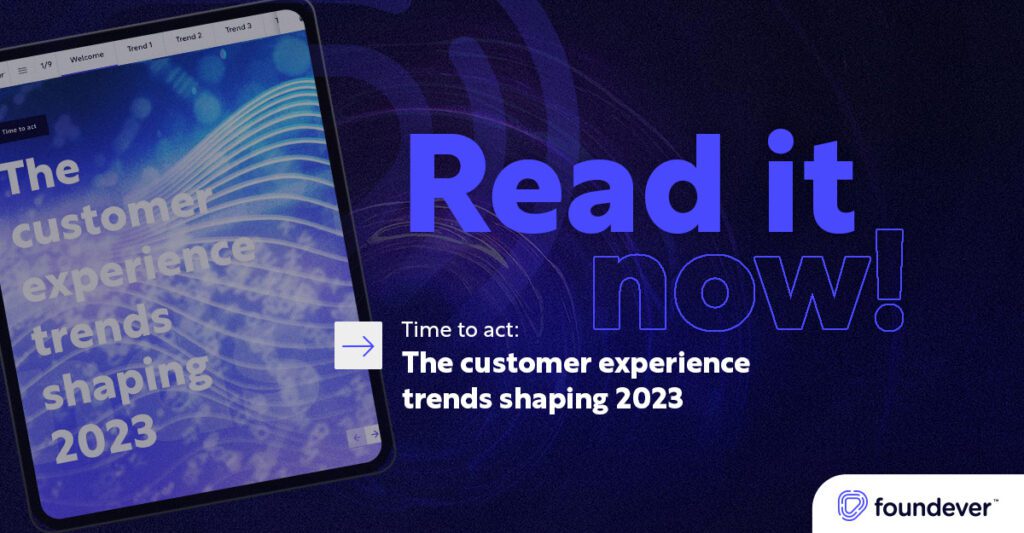Rather than a simple layout of predicted customer behaviors, our report “Time to Act” focuses on five specific steps organizations should take to repair existing inconsistencies in their customer experience operations. The goal for 2023 is to build, maintain and strengthen brand loyalty through existing behavioral CX trends. Based on data collected from a survey of over 6,000 consumers across Brazil, France, Germany, Spain, the U.K., and the U.S., five issues identified through the research — first-party data, social media, skill gaps, technology and traditional channels for customer engagement — could present an opportunity or a threat for organizations in 2023.
Time to realign with customer expectations
This year’s report highlighted the misalignment and disconnect between what customers expect and what organizations deliver via their CX operations. As such, 2023 should be the year organizations realign and reconnect with their customers.
A reconnection doesn’t necessarily mean adding new features and technologies or expanding the existing channel choices. And while consumer expectations and preferences might change, the defining aspects of a positive customer experience as it relates to each channel remain unchanged, as do the steps an organization needs to take to optimize performance.
Building on a strong foundation
And it isn’t until the foundational aspects of CX delivery have been optimized and aligned with customer expectations that organizations can start to move beyond the basics and create greater brand differentiation.
In order to make positive lasting improvements in the way customer experience is delivered, organizations need to view their contact center as a hub for value creation — a space for engagements that improve and strengthen the customer relationship, not for answering frequently asked questions.
Therefore, rather than simply analyzing current metrics and KPIs relating to chat, voice or email, it’s crucial to first examine all touchpoints or steps on the customer journey that sit beyond the contact center’s walls.
Are CX levels slipping?
The first step should be a reexamining of the customer base to understand who they are and their needs, wants and expectations. Our findings indicate that more than one-third of consumers feel the CX they receive is below standard. These findings and any qualitative data collected through a Voice of the Customer (VOC) program and internal and external data sources should provide a holistic view of your customer personas and archetypes.
Mapping the customer journey
Use the personas to identify touchpoints along the customer journey that are ineffective and cumbersome. Customer journey mapping can be challenging and increasingly complex to follow and map, but at the same time, they provide valuable insight into the customer’s perspective.
Customer journey mapping is integral to improving CX and building the business case for projects aimed at elevating performance.
The results of the exercise will, of course, be different for every organization. However, what should be a priority is identifying what could be driving customers to live channels rather than providing other options. Any change to the customer journey that can successfully reduce or deflect live contacts will make the most significant difference to operations.
Focus on getting self-service right
One-in-four consumers prefer to solve their own issues than engage directly with an organization, and 22% of consumers would be happy to use a chatbot to solve problems if it were available.
However, 1% of consumers use chatbots regularly and only 3% say they’re in a position to prioritize self-service with the organizations with which they have a relationship.
This difference between expectations and the reality of brand relationships suggests that in many cases organizations haven’t developed a strong or clear enough self-service strategy. If that is the case, they’re inadvertently driving up the volume of contacts into live channels as customers who attempt and fail to solve their problems are forced to reach out directly for help.
Delivering a self-service experience that meets expectations demands that an organization starts slowly and builds up over time. This usually means beginning with a list of FAQs representative of the most common contact drivers that have a universal answer or solution.
It’s of equal importance to ensure this content is easy to navigate to and navigate through, and that all information remains up to date.
Improve the service over time
Over time, FAQs can be supplemented with a knowledge base that contains more in-depth information or advice, as long as it’s intuitive and easy to interact with. Also, don’t think that advice has to be purely text-based. How-to videos can provide a customer with more insight and guidance than an article. However, as products and services change, updating a video demands more time and effort than rewriting an article or guide.
Within specific industries and for certain types of products and services, there is a growing expectation among consumers for a community or forum where help and advice can be gained that’s grounded in the ownership experience. Communities have the added benefit of helping build greater brand loyalty and advocacy and offering another engagement channel. A community demands a genuine commitment in terms of time and resources, and content and community moderation require a particular skill set.
Use data and insights to automate
Over time, organizations should collect enough data and insights from self-service use and through speech and text analytics operating within the contact center environment to start developing completely automated forms of CX such as chatbots and conversational IVRs. But as with all other aspects of improving and optimizing CX, progress needs to be made one step at a time, and adjustments and updates will need to be made constantly.
Helping customers help themselves allows organizations to lower their operating costs without reducing the quality of the service they provide. However, when they get self-service wrong, those cost savings are lost immediately as contact volumes and average handle times swell and NPS and CSAT scores drop.
Find out more about this year’s five (plus one) major CX trends in our report “Time to act: The customer experience trends shaping 2023.”

